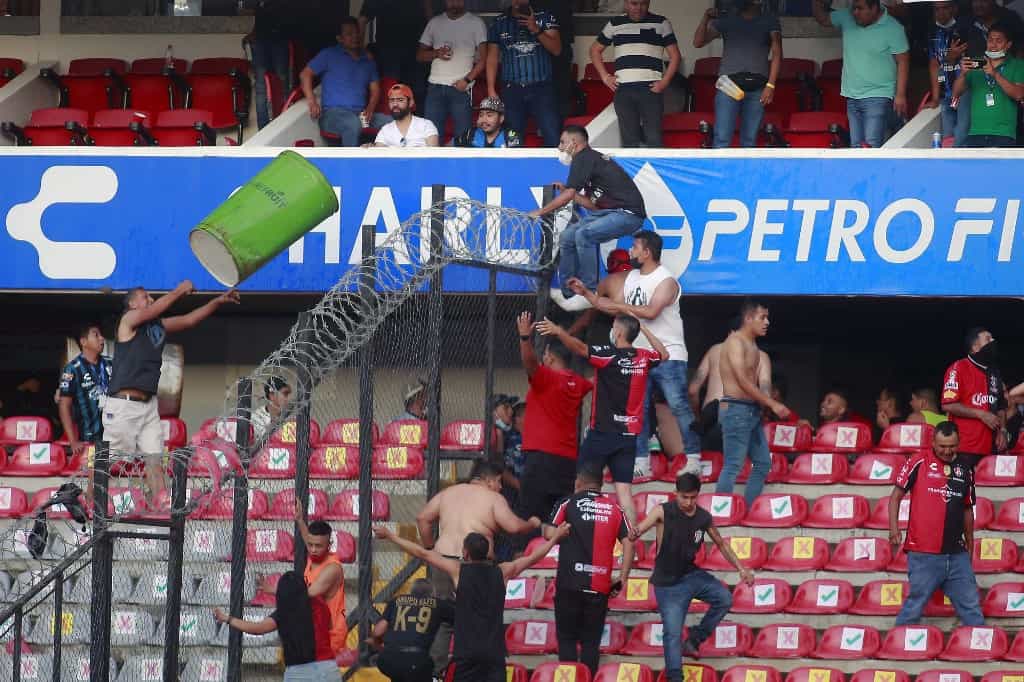The one at the Querétaro stadium in Mexico was one of the most dramatic episodes, but not the most recent nor the last of a scourge that relentlessly torments Latin American soccer: fan violence, which is far from being controlled, according to experts.
The brawl that broke out on March 5 during the game between Querétaro and Atlas, the current Mexican champion, went around the world. The clash between fans left 26 injured, 22 arrested and a battery of sanctions against clubs and fans.
That same night there were aggressions outside the Palmaseca stadium during the derby between América and Deportivo Cali in the Colombian city of Cali.
The following day, a man was shot dead in a clash between fans of Atletico Mineiro and Cruzeiro before a derby in the Brazilian state of Minas Gerais.
And in Uruguay, referees went on strike that day, which was lifted on Wednesday, after two referees received death threats in the space of 12 days and another was the target of an attempted assault by a member of the Danubio club.
Four scenes in different countries of the same problem that has not been adequately addressed by the authorities, despite the fact that it has been staining the game for decades, according to experts.
“There is no way to end violence in soccer, that should be very clear, but it can be reduced. For that a very complete public policy is needed,” Heloisa Reis, author of the book “Soccer and Violence” and professor at Unicamp University in Sao Paulo, told AFP.
Toxic masculinity
Countries such as Argentina, Brazil, Chile, Colombia, Honduras, Ecuador, Peru or Uruguay enacted laws or regulations since the 2000s to prevent riots and punish even with prison sentences.
Some of them replicate actions in Europe to control hooligans, such as biometric identification or video surveillance in stadiums.
After the violent riots in Querétaro, Mexico banned the entry of visiting fans, a measure used or still in force in Argentina, Brazil and Colombia, and questioned by experts because, they argue, violence is transferred to the streets.
Despite everything, the deaths continue to be counted by the dozens: 157 in Brazil between 2009 and 2019, 136 in Argentina in the last 20 years and at least 170 in Colombia between 2001 and 2019, according to academic or NGO studies.
“The great failure of these policies is that they focus exclusively on security,” says sociologist Germán Gómez, a researcher at the Colombian Association of Sports Studies.
The specialists agree that the shock measures are often not applied and tend to ignore the pedagogical work and the social background, such as unemployment, inequality or problematic drug and alcohol consumption. Nor do they attack the complicity of some clubs with the “barrabravas”.
A researcher on the subject for almost thirty years, Reis affirms that the root of the problem is the so-called “toxic masculinity”, a competition between men to conquer power – within the “torcidas” or against rivals in the case of soccer – by means of physical force.
For this reason, he advocates public policies focused on the education of men, the main members of the barrabravas.
But he is not optimistic: “We have been living under male domination for centuries. The male values reproduced are domination, strength, bravery. Is there any prospect of ending that? No”.
Pandemic effect
Although there are no recent figures, specialists perceive a rise in violence since the public returned to the stadiums after the confinement due to the pandemic.
“These are the consequences of such a prolonged confinement, when people return to a public event they have a kind of need to explode”, explains Gómez, without forgetting “the very strong component of violence” of the barras.
In Brazil, for example, since February 12, at least nine violent incidents have been reported, among them the death by a bullet of a Palmeiras fan and aggressions to buses of several teams, which left soccer players injured.
“We are surprised by this aggressiveness in some games,” says Luiz Claudio do Carmo do Espírito Santo, president of the National Association of Organized Fans, which brings together nearly 1.5 million people from almost 200 sports clubs in Brazil.
A member for 28 years of Vasco da Gama’s barra of Rio de Janeiro, the leader assures that these facts are the responsibility of a minority that is not sanctioned.
“They wear a team shirt and are already considered members of the organized supporters, so we are all sanctioned,” he says. “Why didn’t they catch them or punish them? In the next game they’re going to be fighting again.”
by Rodrigo ALMONACID with contributions from regional offices

